Imagine the rest of the Sprites and Dice staff sat around a media room table during last PAX Unplugged as I tell them I’ve taken a game for review all about spellcasting. Imagine, if you will, their surprised-but-not-surprised Pikachu faces as I, their magic-loving, wizard wannabe editor, pulls out a small box shaped like its namesake. Show me a theme that lets me dabble in the arcane and you have my interest. Hook me with its mechanics and you have my attention.
Does Tome, The Light Edition deliver on this promise? The answer for such a small box is surprisingly complex, much like learning magic itself. Let’s dust off this old book then to see if it’s a good fit for your library shelves.
 Tome, The Light Edition
Tome, The Light Edition
Designer: Anthony Thorp
Publisher: Reversal Games LLC
Number of Players: 2 - 4
Price: $15 USD
Copy provided by publisher
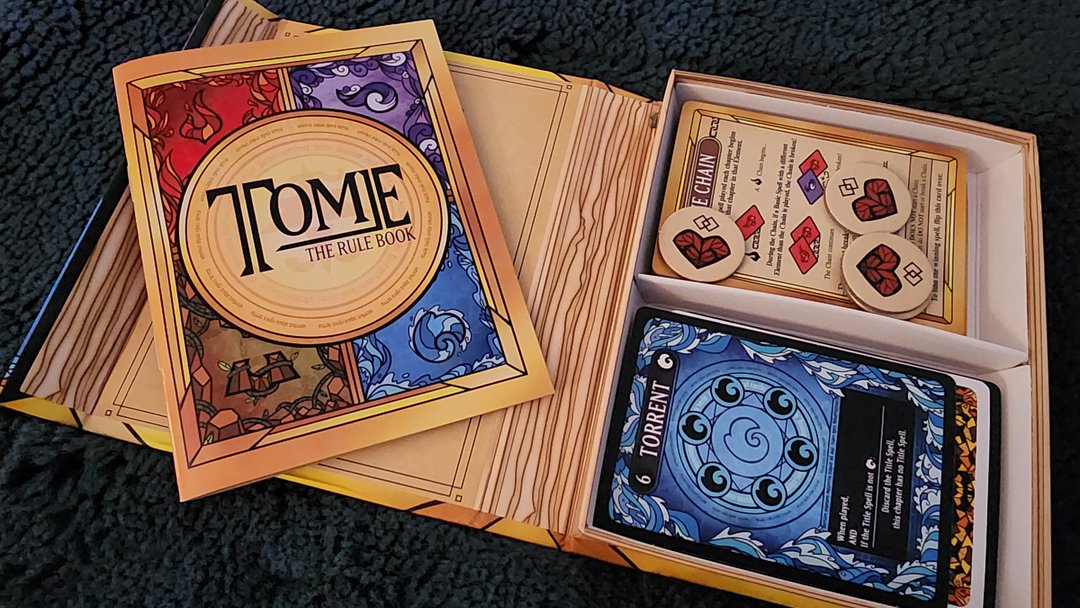
Everything that comes in the box! The box, by the way, has a lovely magnetic latch that seals it.
What’s In This Tome
Let’s start off with what Tome is: a trick taking game where each suit (element) and number (power) all have different special effects. Players will progress as with any trick taking game, playing cards one at a time, attempting to finish the chapter (the trick) with the highest value card on the table. Doing so takes the trick, and it earns that player a point. Players work through a hand of six cards, with the last trick of the round being worth two points.
Each turn a card is flipped off a deck of the remaining, undealt cards denoting the trump suit (referred to in this game as the Title card), a suit that is considered the highest value if a matching element card is played, even when its power number is lower than another non-trump element. For folks that have played trick taking games before, this will all seem very familiar, and even amongst my friends who didn’t know the term “trick taking,” within just a couple hands of play they’d wrapped their heads around the concept. A nice, simple start to something that gets a bit tricky as the magic starts flowing.
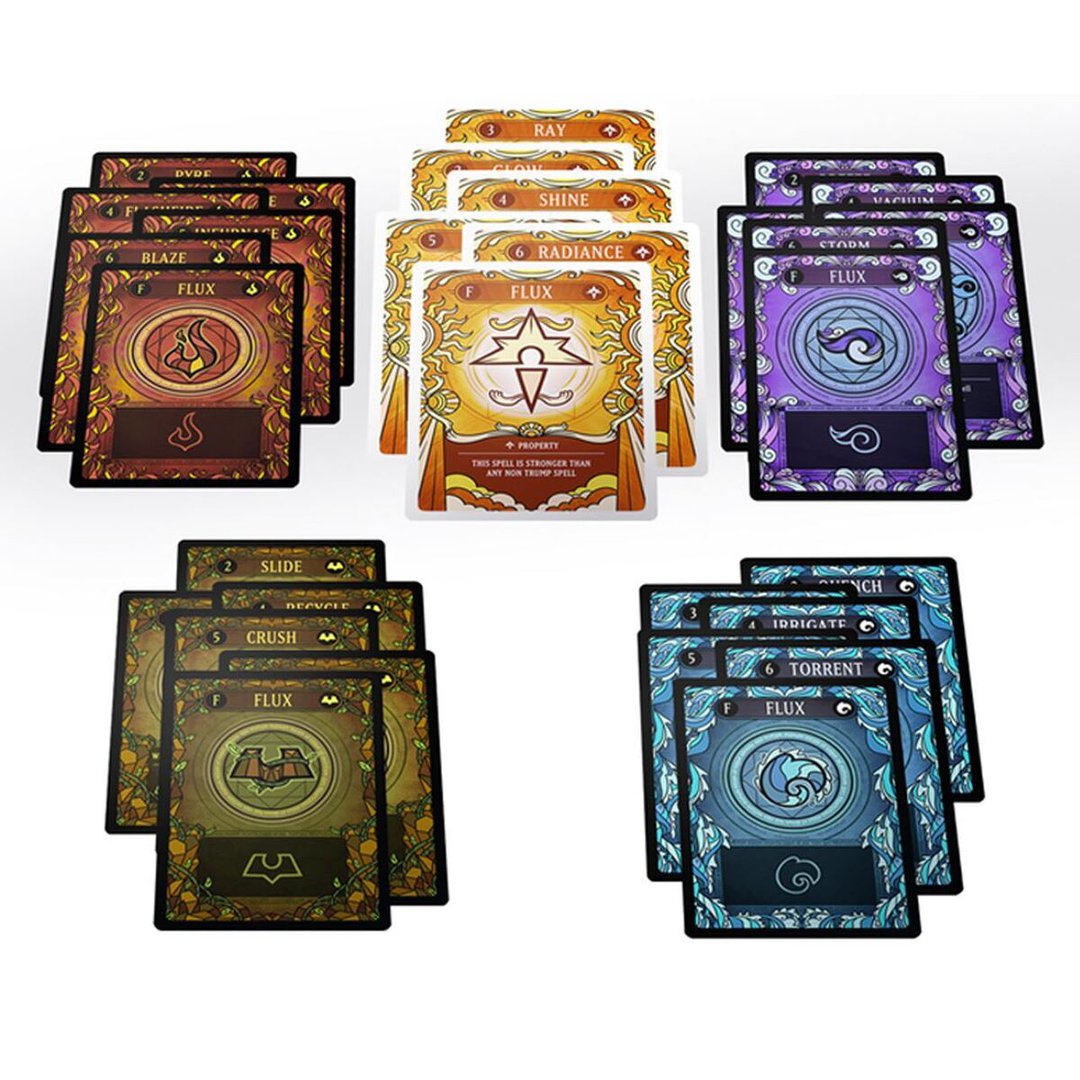
The basic suits. Each specializes in a certain style of play.
The novel addition of Tome to this genre is in the concept of elemental chains. The lead card played in a trick starts a chain, and all players following that card are encouraged to play within the same element. If you do, you can follow the instructions on your card for any special powers it provides. Some of these increase the power of your played card or decrease the power of others. Some allow you to pick up another played card in the trick once it’s done or pick up the trump card if you want it! Some negate other cards’ effects, and some are weirder still, allowing you to change the element of played cards or peeking at what the last trump card to flip off the title deck will be, giving you a little advanced knowledge for that hand that’s worth an extra point.
You’re only suggested to play the lead element, though. The first player who plays a basic element that’s different from the lead breaks the chain. Their card counts for its element and power, but unless it specifically says it ignores breaking the chain it does not get its special magical power. If you break the magical energies everyone else has been channeling, you pay the price! Ironically, after a player breaks a chain, any other players are freed from the confines of the lead element and can play any card they wish for its full effect. Only the chain breaker is penalized. Play continues until one player hits 15 points and leads by at least two points, at which point they are deemed the master mage and the game is over.
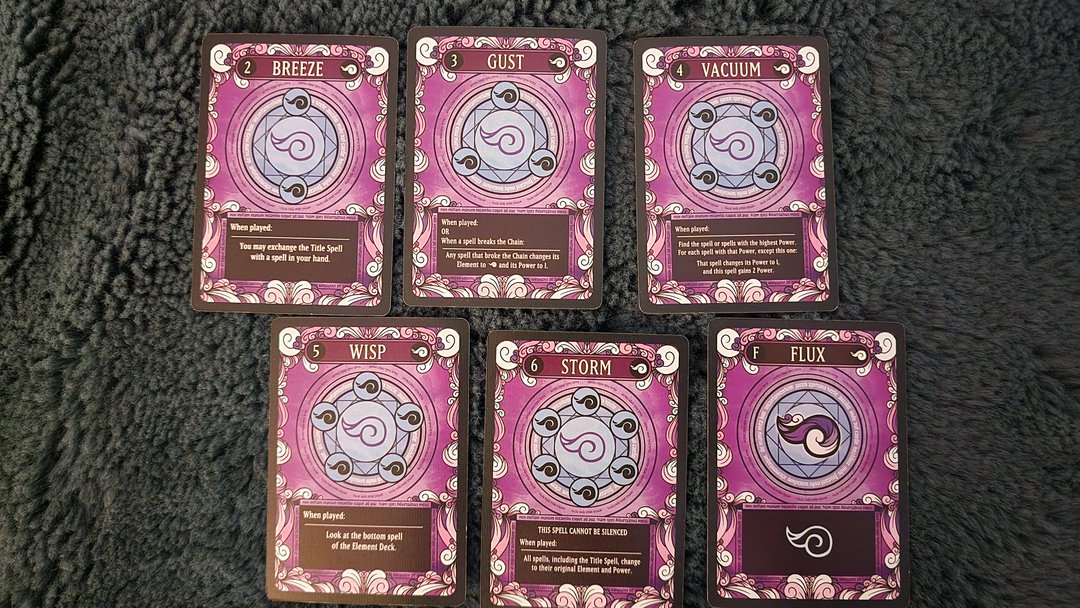
The air suit: control, scrying for information, and clearing enemy effects.
Modes Of Magic
Tome can be played in several different variations. There’s a two-player version in which players draw an extra, random card from a separate pile of cards each hand, playing two each round in a back and forth, attempting to draw out traps and counter-plays from their opponent. There is a standard three-player game in which you remove one basic element from the deck to accommodate the player count. And in the four-player basic game, players play in teams with the person across from them; table talk is not allowed for revealing what players might have for their teammates, as magic is complex business! Finally, there is a survival mode in which players play not to win tricks but to not play the weakest card each turn. Doing so loses a life point, and when two life points are lost a player is eliminated from the round, earning everyone else a point. The longer you live in a round, the more points you stand to earn, with bonuses for finishing the 6th trick or being the last caster standing. In this variant, play ends after only 10 points as long as there are no ties for first place.
A mini expansion called Gold Codex is also available, adding two additional basic elements and one additional special element, to the box. The base rule book has rules for swapping any of these with the standard setup, in case you want more variety or random setups each game. Special elements, it should be mentioned, have their own special properties and do not start or break chains when played, adding just a little bit of extra flair to your spellcasting. The Light Edition comes with one of its own, so you don’t strictly need this expansion. I find the little bit of extra variety is nice to have, though.
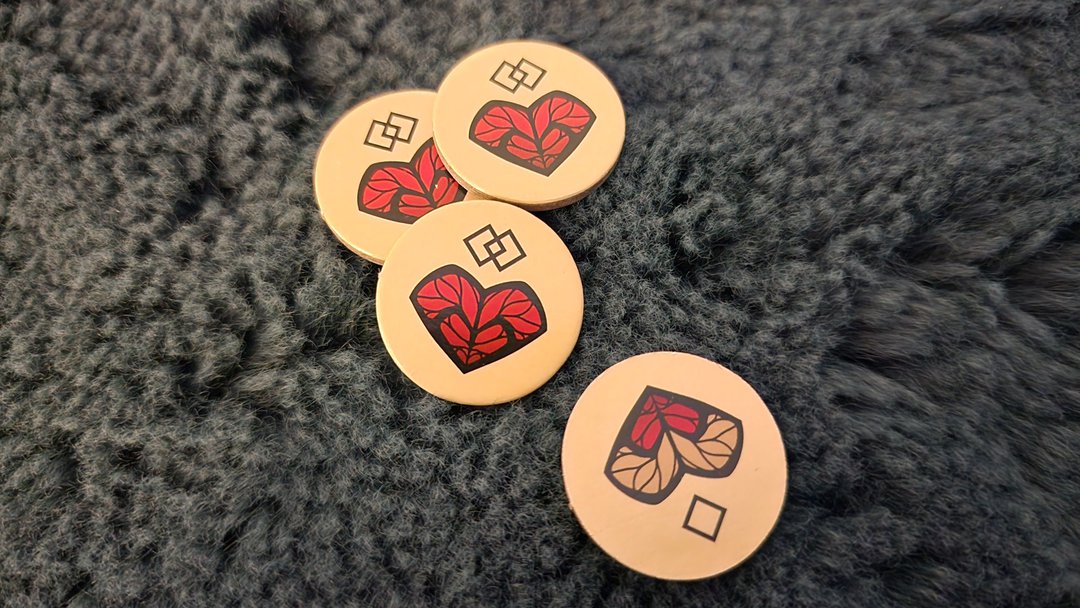
Life points. They run out surprisingly fast, so play risky at your own peril!
Of course, the big question, the one that means the most to me, is whether this game feels thematic. Do you actually feel like a mage casting spells against your opponents? To be honest, I’ve played a bunch of games at this point and the answer is: sometimes. Certainly not at first. In the beginning, it’s enough just to read what’s in your hand, have a basic sort of grasp of their special abilities and strengths, and just try to play. There will be a lot of silly interactions, a lot of players getting “robbed” of what they though were sure victories. These early games are gloriously chaotic. You’ll just have to laugh with them. Thematic, however, they do not feel. Everyone’s trying to concentrate on just playing the game. You’re playing a three of water to win a hand, not a mighty whirlpool spell to sink the opposing mages.
As you play a few games with the basic set of cards, you’ll start to remember which suits are good at what. Fire can grow in power easily, while air has scrying and reset powers, for example. There will be obvious favorite effects that players will look for or scoop up with other spell effects. You’ll start planning ahead, perhaps playing an early five of air (the Wisp) to peek at the last card of the round, planning ahead for those extra points. You’ll withhold your “reset” spell for that hand you know people will be playing other powerful spells. Some cards are better played early in the round. Others are more powerful when played last, or if you can follow someone breaking the chain. Your style will also change with the chosen game mode; we loved playing an early two of water to scoop up an extra card early in the game, but playing it willy-nilly in a game of survival is a recipe for losing unnecessary life points. When this game was at its best was in those moments of clever planning, one magic caster outwitting another, holding a well-timed surprise in hand to counterspell the opposition at just the right moment. In those rare plays the game ascended from just numbers and suits to quashing a raging fire spell with a well-placed burst of water.
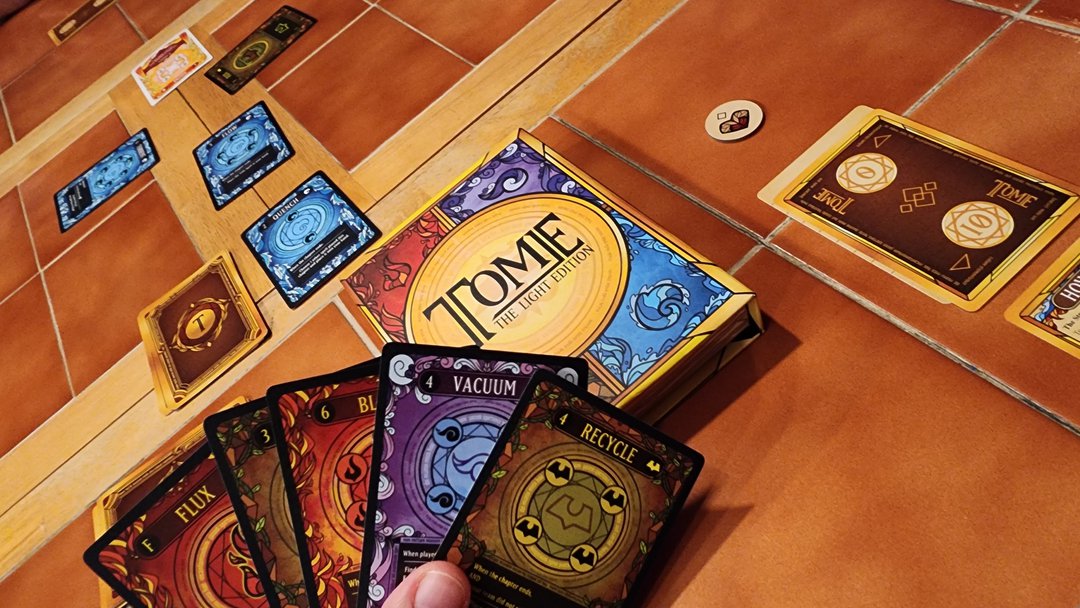
It's all about what you hold back. Blow your big spells early and you might be stuck in a bad spot for the rest of the round.
The Variety Of The Arcane
I started out in this review with the measured stance of “this game is good, but I’m not sure I’d recommend it over other more technically tight trick takers unless you’re in love with theme.” By the tone of that sentence, though, I’m sure you can tell I’m about to counterspell my own criticism, and that's because of last week’s game night. While finishing this review I had one last chance to play Tome, and in fact we spent the entire night playing it! At first it was just teaching some new players the ropes. Then it was “they have to try out survival mode.” Then, of course, we had to stack the deck with all the new cards in the Gold Codex. There are rules for mixing up the elements at random. We didn’t use them.
By the end of the night I had to admit we’d all had a great time, and frankly isn’t that the point of any board game? I asked my friends how thematic they thought the magic tone of the game was, and they admitted it felt decently strong. I was also impressed by the fact that the game’s spells work so well in so many different modes, especially between the vastly different survival mode, in which you don’t actually need to take tricks, versus the team variant “main mode” in which you definitely want to play highest. Usually, games that include multiple modes sacrifice tightness in the gameplay for the variety they offer. The oft-leveled criticism is that they’d be better if they picked one lane and went hard on it, but I found I didn’t mind so much with Tome. Sure, the game could be that much tighter when designed purely around one mode of play, but I find that I actually prefer the variety in this case. I’ll get to exactly why in just a moment.
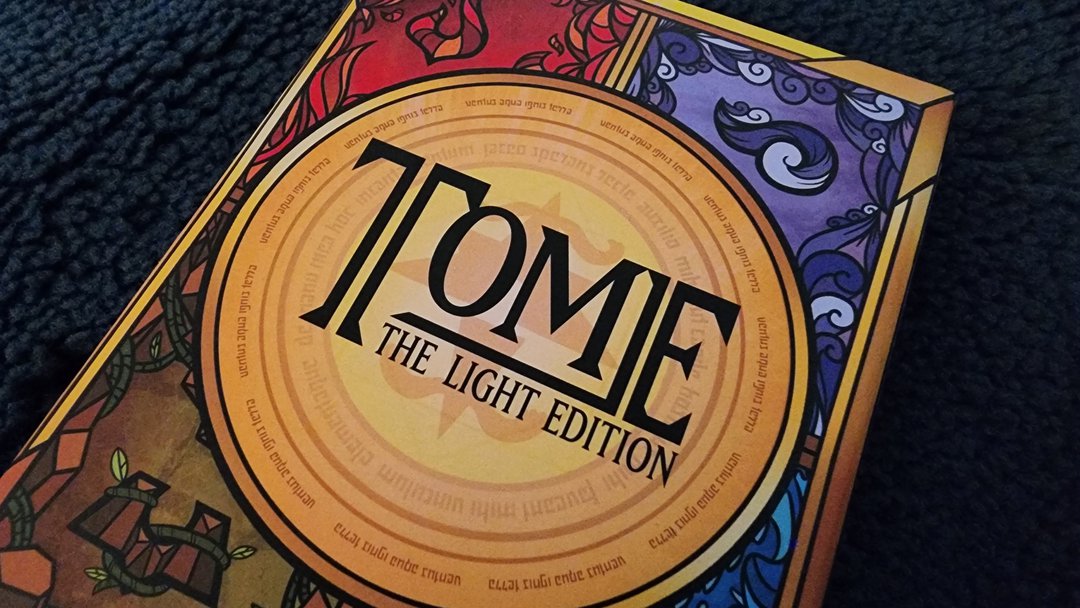
There is something enchanting about a small box with a big heart.
Similarly, swapping out elements creates weird imbalances in how the cards interact, but I find that these are fun quirks to play around rather than things that break the game. If you’re a master mage card counter you’ll definitely enjoy the realization that you can “get away” with certain riskier plays knowing that some cards have been played while others aren’t in play at all. In fact I would go so far as to say that, along with the aforementioned point on game modes, the wacky variety and interactions of this game aren’t just a quirk of the design. Or a limitation begotten from splitting how the game is played. They’re a feature! Why would I recommend Tome over other trick takers, besides for its theme? In a way, I think it has a playfulness that other trick takers lack. Many in the genre I’ve played are tight. They are brain burners. They are so solid you could build the foundation of your house on them. I would describe some of the best on my shelves as purely brilliant. And sometimes that makes them hard to get to the table when folks want a more chill or silly game.
If I had one serious criticism of Tome, it would be of the two-player mode. Honestly, it’s just okay. The extra random card draw every turn gives you a nice element of imperfect information and cards you don’t care about throwing away to draw out plays for your better stuff. Though you still have considerations to worry about like breaking chains. Still, I feel like this is the most “tacked on” way to play for a game that’s really at its best in the 3-4 player count. That said, the game loses absolutely nothing by its inclusion. Play it or just save the game for three to four players. I’ve made the same recommendation for just about any game published by Leder Games that we’ve reviewed here, and we love all those titles too. Also sometimes the wording on cards can be a little confusing, but if two cards have an interaction your group cannot rule through just make an executive decision on whatever seems most fun and play on. We experienced it and it really wasn’t that big of a deal, especially given the quirky nature of spell interactions that are more a plus for this game. Overall, Tome is a solid little game of trick taking magic, and I’m glad to have it in my game library. As wacky, modular trick taker’s go, this is one of the most fun ones I’ve played in a while. If you think it looks like it might have a spot on your shelves, I encourage you to grab a copy!